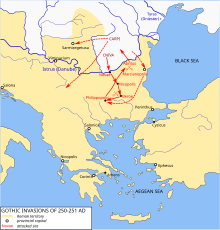Gothic wars
This article needs additional citations for verification. (April 2023) |
This article possibly contains synthesis of material which does not verifiably mention or relate to the main topic. (April 2023) |
| Gothic wars | |
|---|---|
| Part of the Iberia | |
| Result |
Gothic victory:
|
The Gothic wars or Roman–Gothic wars[citation needed] were a long series of conflicts between the Goths and the Roman Empire between the years 249 and 554 AD.[according to whom?] The main[according to whom?] wars are detailed below.
History
Crisis of the Third Century

During the

The greatest Gothic invasion so far occurred in 268. The Goths' seaborne allies, the
Fourth century
Gothic war: 367-369
The Gothic king Ermanaric of a large powerful kingdom north of the Danube from the Black Sea,[3] had engaged to supply the usurper Procopius with troops for the struggle against Roman Emperor Valens. The Gothic army, reportedly numbering 30,000 men, arrived too late to help Procopius, but nevertheless invaded Thrace and began plundering the farms and vineyards of the province.[4] Valens, marching north after defeating Procopius, surrounded them with a superior force and forced them to surrender.[5] In the spring of 367, Valens crossed the Danube and attacked the Visigoths under Athanaric. The Goths fled into the Carpathian Mountains, and the campaign ended with no decisive conclusion. The following spring, a Danube flood prevented Valens from crossing; instead he had his troops construct fortifications. In 369, Valens crossed again, from Noviodunum, and by devastating the country forced Athanaric to attack him. Valens was victorious, and Athanaric received Ermanaric's permission to conclude a truce. Athanaric pleaded for treaty terms and Valens gladly obliged. The treaty seems to have largely cut off relations between Goths and Romans, confining trade and the exchange of troops for tribute.[6]
Gothic war: 376–378
The Gothic Revolt of Tribigild in 399-400 in Anatolia (Eastern Roman Empire) caused a major political crisis during the reign of Emperor Arcadius (395-408). The uprising was led by Tribigild, leader of a unit of Goths within the Roman army. Initially, the uprising only took place in Anatolia, but after the commander-in-chief of the Eastern Roman army Gainas intervened and sided with the Goths, it became a threat to the unity within the Eastern empire.[citation needed]
Fifth century and later
Visigoths fought against the Western Roman Empire. In 401 Alaric I invaded Italy, but he was defeated by Stilicho at Pollentia (modern Pollenza) on April 6, 402. A second invasion that same year also ended in defeat at the Battle of Verona, though Alaric forced the Roman Senate to pay a large subsidy to the Visigoths, and devastated Greece.[citation needed] Later, Alaric led the Sack of Rome (410).[citation needed] The War of Radagaisus was a military conflict in northern Italy caused by the invasion of Radagaisus in 405. He invaded the Western Roman Empire with a huge population shortly after the empire had ended a war with the Visigoths. Due to the size of Radagaisus' army, it required a tremendous effort by the Romans to avert this danger. Commander-in-chief Stilicho was closely involved in the preparations that were made and personally directed the army's operations.[citation needed]
Gothic war: 436–439
Gothic war: 535–554
The Gothic War between the
References
- ISBN 0-415-23943-5p. 347
- ^ Varbanov, Varbin. Barbarian Invasions in the Roman Provinces of Lower Moesia and Thrace in the mid-Third Century and the Coin Hoards from that Period
- ^ Gibbon, Ibid. p. 890, 891
- ^ Gibbon, Ibid. p. 892
- ^ Emperor Valens’ War with the Goths During 367-369 June 2016 DOI10.18503/1992-0431-2016-2-52-145-151 Sergey V. Yartsev
- ^ Gibbon, Ibid. p. 893, 894
- ^ Heather, 2005, p. 146.
- ^ Wolfram, 1997, pp. 85–86.
